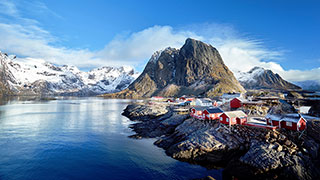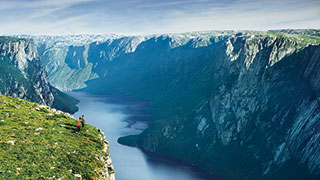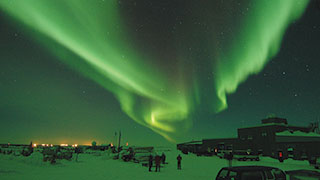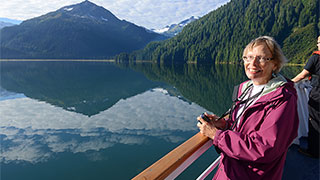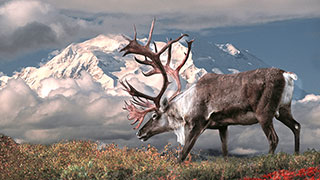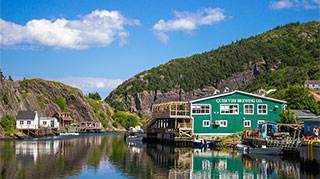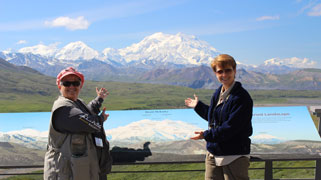The Arctic & Antarctic

From Alaska to Antarctica, discover the best of Road Scholar's polar adventures. Whether it's sailing through the spectacular fjords of Norway or crossing off the 7th continent, there is much to learn from these vast and wild landscapes.
- Most Popular
- Relevance
- Price
- Start Date
- Title Asc
- Title Desc
Newfoundland & Labrador: Gros Morne & the Northern Peninsula
Hike the Discovery Trail: Five Centuries of Newfoundland Coastal Life
Coastal and Mountain Hiking in Gros Morne National Park
Guided Arctic Tours
Don’t let frigid temperatures deter you—people have been visiting the Arctic for thousands of years to explore its unique wildlife, climate, and landscapes. At Road Scholar, our educational Arctic tours will bring you from Alaska to Antarctica, so you can explore the world’s polar regions in a unique and engaging way. Whether you’re sailing through the fjords of Norway or crossing off the 7th continent on your list, our Arctic travel tours will bring you through these vast and wild landscapes.
Planning Your Arctic Tour
Arctic travel isn’t for the faint of heart; its extreme temperatures and diverse landscape may be unrecognizable to most, but offer an experience of a lifetime. When it comes to planning your Artic tour, it’s essential to know what to expect. From glaciers to boundless, wide skies and icebergs to rolling tundra, there’s a lot to explore in the Arctic regions.
To plan accordingly, it’s essential to invest in the right gear. Stock up on:
- Thermal undergarments
- Ski goggles
- Hand and feet warmers
- Arctic boots
- Sunscreen
- Waterproof ski pants
- Parka
- Fleece
- Thermal gloves and socks
- Wool or fleece hat
These are just some of the essential pieces of gear you’ll need to ensure your Artic tour goes to plan. At Road Scholar, our expert instructors will take care of all the heavy planning for you, including your transportation, lodging, and food, so you can experience the Arctic to the fullest. They’ll also provide you with an itinerary and a list of gear you’ll need to make the most out of your trip.
Popular Trips to the Arctic and Beyond
The Arctic Circle and beyond is known for a wide range of popular destination spots. At Road Scholar, our selection of Arctic tours can bring you to popular areas across this region, such as:
- South Shetland Islands, Falkland Islands, and South Georgia to learn about the wildlife and geology that shaped Antarctica
- Alaska to explore the wildlife and glaciers that make this state famous
- Nordic countries such as Sweden, Norway, Denmark, and Finland to explore Scandinavian design and cultures
- Gros Morne National Park in Newfoundland for mountain hiking
- Expedition cruises to areas like Greenland to explore fjords, wildlife, and glaciers up close
These are just some of the most popular Arctic vacation spots that you can visit through Road Scholar. Browse our full selection to see where we can take you next.
Tips for Arctic Travel
The Arctic is a beautiful region filled with rich biodiversity, wildlife, and cultures. However, the extreme climate and weather can be challenging for new and veteran explorers alike, which is why it’s essential to be prepared.
Our top five tips for Arctic travel?
- Bring sunscreen and sunglasses—the sun’s reflection off the snow can be extremely strong
- Be open to trying new things, such as cuisine and local activities like dog sledding
- Pack a durable camera to document your adventures
- Pack properly with many layers to ensure you’re comfortable throughout your trip
- Respect the wildlife by watching from a distance
Choosing to Tour with Road Scholar
Touring the Arctic with Road Scholar is a great way to learn about the world’s North and South Poles in a unique and engaging way. Led by expert instructors, you’ll get the chance to gain privileged access to top destinations and learn about history, culture, landmarks, and more. From touring on our expedition ships to walking tours of Arctic towns and cities, our Arctic tours will provide memories that will last.
FAQ
1. Where exactly is the Arctic?
The Arctic is considered all of the Earth north of the Arctic Circle (located approximately 66 degrees north of the equator).
2. How big is the Arctic?
There are 5.5 million square miles that make up the Arctic. The Arctic spans regions belonging to eight countries:
- Canada
- The Kingdom of Denmark, including Greenland
- Finland
- Iceland
- Norway
- Russia
- Sweden
- and the United States
3. Is the Arctic inhabited?
The Arctic is inhabited by several different groups of indigenous people as well as immigrants of European descent. There are three groups of Alaska Natives: the Inuit, Aleut, and Indian, and in Russia, there are 16 recognized indigenous peoples. The Canadian Arctic has about 50,000 indigenous people.
4. What kinds of animals are in the Arctic?
The polar bear, beluga whale, caribou, arctic fox, narwhal, musk ox, snowy owl, arctic hare, and walrus are some of the animals that live in the Arctic. There are also many bird species, including the puffin and the common eider.
5. What is there to do in the Arctic?
-
See the northern lights: The aurora borealis can be experienced year-round but is best viewed as late in the year as possible.
-
Spot polar bears: The chances of catching a glimpse of polar bears are better in the Spitsbergen area of Norway or along the coast of Greenland.
-
Viking history: Greenland has extensive Viking history that can still be experienced there today. The Hvalsey Church, built around 1300 A.D., is still standing.
-
Whale watching: Check out the whales that migrate through the Arctic and one that calls it home. Humpbacks, blues, bowheads, minkes, and fins all make the annual trip to the North Pole, and belugas stay year-round.
-
Explore by kayak: Taking a kayak out on the water offers you a once-in-a-lifetime chance to get close to the Arctic environment and its inhabitants.
6. Is it true that there is around-the-clock sunshine in the Arctic in summer?
Yes, that is true. The North Pole stays in full sunlight all day long for the entire summer. After the summer solstice, the sun starts to fall towards the horizon. In the Arctic winter, there is no sunlight at all until the beginning of March.
7. How is the Arctic different from Antarctica?
One big difference between the Arctic and Antarctica is that the Arctic has been inhabited for thousands of years and offers fascinating culture alongside stunning wildlife. Antarctica is one large land mass surrounded by water, while the Arctic is a huge region that spans one-sixth of the Earth's area and includes everything north of the Arctic Circle.
8. Are the seas turbulent in the Arctic?
The Arctic consists of mostly sheltered waters without many open sea crossings. It is still a good idea to bring seasickness medicine if you are prone to motion sickness.

